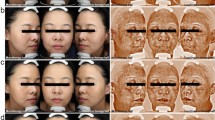Abstract
Melasma is an acquired pigment disorder showing symmetrical hyperpigmentation of the face characterized by light to dark brown patches with indistinct borders on both cheeks. Melasma is prevalent in middle-aged women with harmless hormone imbalances. It is also known as the mask of pregnancy and is prevalent in most child-bearing women. It fluctuates month by month, and yet, there is no promising treatment. The Q-switched neodymium-doped yttrium aluminum garnet (QS-Nd:YAG) laser (1,064-nm wavelength) was introduced in Asia years ago for both skin toning and treatment of facial pigment. This low-fluence, 1,064-nm QS-Nd: YAG laser also reportedly improved melasma. Adjunctive treatments such as vitamin C iontophoresis or chemical peels were recommended in other reports. The technique using the 1,064-nm QS-Nd:YAG laser for toning and the enhancement of adjunctive treatments need further investigation and long-term follow-up before recommendations for the ideal protocol for melasma treatment can be made. The aim of this study is to evaluate the improvement of melasma using different parameters with the 1,064-nm QS-Nd:YAG laser with ultrasonic application of topical vitamin C. Eight patients, ranging in age from 32 to 45 years (mean 37 years), with long-term melasma were studied. Most of the melasma cases were dermal or mixed-type melasma. The patients had no cosmetic treatment (laser, intense pulsed light, or chemical peel) 1 year prior to the study. The entire face of each patient was treated with the 1,064-nm QS-Nd:YAG laser for four sessions at 1-month intervals. The laser treatment was divided into three parts with different parameters. First, each patient underwent whole face exposure for one pass with an 8-mm spot size at a power of 2.0 J/cm2. Next, the spot size was shifted to 6 mm at a power of 3.5 J/cm2 for one full-face pass, and then ended with a 4-mm spot size at 3.2 J/cm2 for one full-face pass, with multiple passes for the main lesions. The end point was mild erythema and swelling, without petechiae. All patients applied ice packs for 5 min before the adjunctive treatment. We designed a split-face study with or without ultrasonic application of topical vitamin C. Only the right side of the face received ultrasonic melasma application of vitamin C for 15 min after ice packing. The left side of the face was covered with a moisturizing lotion. Objective evaluation was performed with visual analog score. All eight patients completed the 3-month follow-up after the four laser treatments. Statistics showed significant improvement with ultrasonic application of vitamin C compared to laser monotherapy. The improvement was more pronounced during second to fourth sessions. There was no rebound or post-inflammatory hyperpigmentation detected during the 3-month follow-up period. The combination of 1,064-nm QS-Nd:YAG laser treatment with ultrasonic application of topical vitamin C exerted more prompt response of melasma. We recommended this protocol including mixed parameters of 1,064-nm QS-Nd:YAG laser toning method combining with vitamin C ultrasonic application that can yield higher satisfaction for the difficult facial pigmentation problems such as melasma.




Similar content being viewed by others
References
Lieu TJ, Pandya AG (2012) Melasma quality of life measures. Dermatol Clin 30(2):269–280, viii
Bansal C et al (2012) A comparison of low-fluence 1064-nm Q-switched Nd:YAG laser with topical 20 % azelaic acid cream and their combination in melasma in Indian patients. J Cutan Aesthet Surg 5(4):266–272
Kim JE et al (2013) Histopathological study of the treatment of melasma lesions using a low-fluence Q-switched 1064-nm neodymium:yttrium-aluminium-garnet laser. Clin Exp Dermatol 38(2):167–171
Lee CN et al (2009) Effects of Q-switched and long-pulsed 1064 nm Nd:YAG laser on enlarged facial pores. Photodermatol Photoimmunol Photomed 25(6):328–330
Liu H-X et al (2012) Treatment of melasma with low fluence, 1064-nm Q-switched Nd:YAG laser in Chinese patients: P07-03. J Dermatol 39(1):151
Park KY et al (2011) A randomized, observer-blinded, comparison of combined 1064-nm Q-switched neodymium-doped yttrium-aluminium-garnet laser plus 30 % glycolic acid peel vs. laser monotherapy to treat melasma. Clin Exp Dermatol 36(8):864–870
Sobhi RM, Sobhi AM (2012) A single-blinded comparative study between the use of glycolic acid 70 % peel and the use of topical nanosome vitamin C iontophoresis in the treatment of melasma. J Cosmet Dermatol 11(1):65–71
Kauh YC, Zachian TF (1999) Melasma. Adv Exp Med Biol 455:491–499
Javaheri SM et al (2001) Safety and efficacy of glycolic acid facial peel in Indian women with melasma. Int J Dermatol 40(5):354–357
Moin A, Jabery Z, Fallah N (2006) Prevalence and awareness of melasma during pregnancy. Int J Dermatol 45(3):285–288
Failmezger C (1992) Incidence of skin disease in Cuzco. Peru Int J Dermatol 31(8):560–561
Freitag FM et al (2008) Effect of melasma on quality of life in a sample of women living in southern Brazil. J Eur Acad Dermatol Venereol 22(6):655–662
Balkrishnan R et al (2003) Development and validation of a health-related quality of life instrument for women with melasma. Br J Dermatol 149(3):572–577
Davis EC, Callender VD (2010) Postinflammatory hyperpigmentation: a review of the epidemiology, clinical features, and treatment options in skin of color. J Clin Aesthet Dermatol 3(7):20–31
Wattanakrai P, Mornchan R, Eimpunth S (2010) Low-fluence Q-switched neodymium-doped yttrium aluminum garnet (1,064 nm) laser for the treatment of facial melasma in Asians. Dermatol Surg 36(1):76–87
Polnikorn N (2008) Treatment of refractory dermal melasma with the MedLite C6 Q-switched Nd:YAG laser: two case reports. J Cosmet Laser Ther 10(3):167–173
Ros JR, Rodriguez-Lopez JN, Garcia-Canovas F (1993) Effect of L-ascorbic acid on the monophenolase activity of tyrosinase. Biochem J 295(Pt 1):309–312
Conflict of interest
The authors have no conflict of interest to disclose.
Funding
There are no funding sources for this work.
Author information
Authors and Affiliations
Corresponding author
Rights and permissions
About this article
Cite this article
Lee, MC., Chang, CS., Huang, YL. et al. Treatment of melasma with mixed parameters of 1,064-nm Q-switched Nd:YAG laser toning and an enhanced effect of ultrasonic application of vitamin C: a split-face study. Lasers Med Sci 30, 159–163 (2015). https://doi.org/10.1007/s10103-014-1608-2
Received:
Accepted:
Published:
Issue Date:
DOI: https://doi.org/10.1007/s10103-014-1608-2




